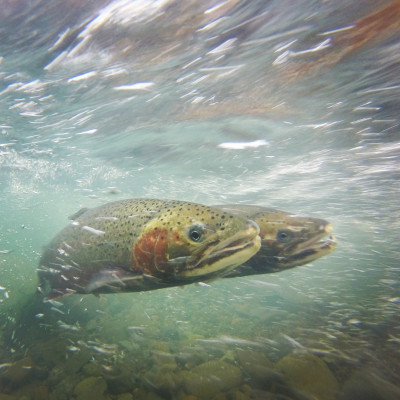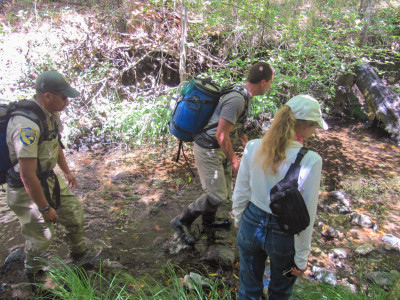The powerful but graceful dance of salmon swimming, fighting, and leaping their way upstream as they migrate back from the ocean to their spawning tributaries is a captivating marvel to behold. Many people in the Russian River watershed grew up watching salmon and steelhead return to the streams each winter but, with drastic population declines, it is a sight far less common than in the past.
“Our friends and relatives would come up from the city to have Easter and come visit with us. We'd always walk up to the falls and watch the fish jump up the falls. You could stand there for half an hour and count maybe 15 or 20 of them jumping. It was a big deal.” says local, streamside landowner Robert Lownes. Lownes’ family has a rich history with Mill Creek—a salmon stream in Healdsburg, where they have owned property since the early 1900s—and Lownes is all too familiar with the plight of these fish.
Coho salmon populations, once estimated to return to Russian River streams in the tens-of-thousands, dropped to fewer than 10 adults per year by the early 2000s. Today, thanks to intensive, collaborative efforts by resource agencies, non-profit organizations, private businesses, educational institutions, and thousands of private landowners, the coho population is slowly climbing its way back and hundreds of adults are now returning each winter.

Lownes and others who own property along the tributaries of the Russian River are a critical piece in the complex puzzle of salmon and steelhead recovery in the basin. Streamside landowners have a unique opportunity to act as stewards of the creeks where these threatened and endangered fish spend much of their lives, but the entire watershed community has an important role to play.
California Sea Grant’s Russian River Salmon and Steelhead Monitoring Program has been working to help the fish populations by conducting research and monitoring in the region since 2004. Located in Windsor, California, they monitor native coho salmon and steelhead at every life stage, provide scientific information to the many diverse stakeholders, and work closely with partners to inform and support salmonid recovery.
To accomplish all of this, they must rely on one key component: access to the streams. Nearly all of the roughly 1,500 square-mile Russian River watershed is privately owned. Thus, none of this work would be possible without the support of thousands of streamside landowners throughout the region, whose permission to access the creeks on their lands is critical to the success of this extensive effort.
Thankfully, there are many in the area who are passionate about helping the salmon and steelhead and are happy to contribute in any way they can.
“In the state of California, salmon historically provided a huge economic value. And so there's a real incentive to try to protect and restore salmon fisheries,” says Nancy Summers, whose land along East Austin Creek is a conservation bank for the restoration of coho salmon and steelhead. “And then there are the people who just feel that their environment is enriched by having wildlife and plant life around them. For me, I just really appreciate wildlife and plant life in my environment.”

Salmon are not just an animal that inhabit the river. They are an integral part of the local culture of the Russian River community and carry a deeper meaning for many of the people who live there. They are also keystone species on which the health of the entire ecosystem depends.
“The fish have been bringing minerals and other things—the protein of their body—back from the ocean to our land for time immemorial,” says Sally Weed, who has been farming a small vineyard alongside Grape Creek since 1998. “It’s a wondrous way to connect with the plants and the land. The fish are the key to how to do that.”
Today, the fish that have been so steadfast in nurturing the Russian River watershed for millennia are dependent upon us for their survival. Building on efforts that include a conservation hatchery program and broad-scale habitat enhancement, the success of restoring these fish populations ultimately depends, in large part, on the participation of the local community. Fortunately, many people are willing to go above and beyond.
Weed, for instance, has participated in fish habitat restoration on her section of stream and supported streamflow enhancement through the Russian River Coho Water Resources Partnership. Summers has worked with the California Conservation Corps to restore habitat, plant native species, and stabilize streambanks. Lownes hosts a PIT-tag antenna array on his property to help with tracking tagged fish, and even supplies the energy to power the equipment.
“This is one small thing I can do for the salmon,” says Lownes. Perhaps if each of us does one small thing, there will be hope for the fish. For streamside landowners, that one thing can be as simple as granting access for the monitoring that is critical to guiding recovery efforts.
This month, the California Sea Grant team, along with some of their partners at California Department of Fish and Wildlife, Sonoma Water, and the Army Corps of Engineers, embark on the substantial task of renewing their agreements with thousands of landowners throughout the watershed—from Jenner north to Redwood Valley. This presents a vital opportunity for them to connect with the community so that they can expand the reach and impact of their research, as well as bring more people together to increase the potential for salmon and steelhead recovery in the much-loved Russian River watershed.

“One of the best parts of my job is getting to connect with so many amazing people in the community,” says California Sea Grant biologist Sarah Nossaman Pierce. “Most of the landowners I talk to are deeply invested in the streams on their properties and I learn so much from them.” Pierce has been working with the program since 2009. “There is nothing simple or short-term about recovering endangered species,” she says. “In this case, it will truly take a village, a collective commitment from all us living in the watershed.”
Not everyone needs to take on intensive projects to honor that commitment. Something as simple as granting access permission to the team if you receive a request letter is invaluable in ensuring that this work can continue.
“All I did was say yes,” says Weed. “I really can’t say enough positive things about it. I know it was the right thing for the fish and the ecosystem.”
Resources to learn more about monitoring and restoration efforts in the Russian River watershed:
About California Sea Grant
NOAA’s California Sea Grant College Program funds marine research, education and outreach throughout California. Headquartered at Scripps Institution of Oceanography at the University of California San Diego, California Sea Grant is one of 34 Sea Grant programs in the National Oceanic and Atmospheric Administration (NOAA), U.S. Department of Commerce.